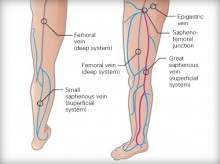Vein Disorders and Sclerotherapy
Veins are the type of blood vessel that carries the body’s blood supply back to the heart. When the body’s different organs and systems take oxygen from the blood, that blood is released into the veins and goes directly to the heart and lungs for more oxygen. The lungs take carbon dioxide, a waste product, out of the blood and then put oxygen back into the blood so that it can be carried out to the body’s different systems again.
The veins are also used to store unused blood when the body is inactive. They store the blood and release more when the body becomes more active.
Veins are classified based on their function and their location within the body. Superficial veins are those veins which are close to the surface of the skin, while deep veins are located closer to the center of the body.
Vein Disorders: An Overview
Veins may develop disorders where the blood does not circulate through them properly and instead pools and causes the veins to bulge. Varicose veins, spider veins and hemorrhoids are all variations of this type of disorder. Woman and the elderly are both more likely to develop these disorders of the veins.
Varicose veins occur when blood fails flow properly through the veins and instead pools in them. Varicose veins are distinguished by the fact that the veins become visible and bulge to the point that they are palpable. Varicose veins can develop almost anywhere in the body but occur most often in the legs and thighs. The veins are usually long and dilated.
Spider veins appear near the surface of the skin and are so named because they can resemble a fine spider web. Unlike varicose veins, the lines of spider veins are short and fine and the veins are not palpable. They occur most often on the ankles, feet, thighs and face
Hemorrhoids are a vein disorder occurring specifically in the veins of the anus and rectum. Like varicose and spider veins, hemroids occur when blood pools in the veins and they swell. Hemorrhoids may occur internal to the anal canal or external to it, near the anal opening. When hemroids are external, they can be visible and palpable. Internal hemroids are usually not visible or palpable unless they become prolapsed, a condition where the hemroids sag and extend out of the anal opening.
Veins disorders like hemorrhoids and varicose veins run the risk of developing into more serious conditions if left untreated. Clotting, also known as thrombosis can occur. Additionally, discomfort in the form of itching, swelling and pain may be experienced. In the case of hemroids, ulceration and bleeding may occur in the tissue.
Causes of Vein Disorders
Vein disorders like hemorrhoids, varicose veins and spider veins are caused by multiple factors. Pregnancy and childbearing, weight gain, prolonged standing and sedentary lifestyles can all contribute to hemroids and other vein disorders, as they all put pressure and strain on the veins for prolonged periods of time, thus hampering circulation and causing swelling.
Weak veins are another potential cause of hemorrhoids and other vein disorders. When the walls of the blood vessels are weakened due to factors like disease, aging and heredity, they are more prone to swell and bulge, thus leading to disorders like hemroids and varicose veins.
Treatments for Vein Disorders
The most effective treatment for vein disorders like hemorrhoids really depends upon what stage of severity the condition has reached. In more severe cases of these disorders, treatments via laser, surgery or sclerotherapy may be appropriate.
Sclerotherapy is a hemorrhoids treatment that has become very popular. In sclerotherapy, a chemical agent is injected into the hemorrhoids or varicose veins. This sclerotherapy agent causes the blood vessels to shrink up and eventually disappear. Hypertonic saline and sodium tetradecyl sulfate are two solutions commonly used in sclerotherapy, and Aethoxyskerol (Polidocanol) is a new solution for sclerotherapy treatment that is currently awaiting approval by the FDA.
Sclerotherapy has a high success rate for treating conditions like hemorrhoids and varicose and spider veins. The downside to sclerotherapy is that the sclerotherapy treatment does not prevent the disorder from occurring in other veins, so there may be recurrence of the hemroids or other vein disorders. If recurrence of the hemroids or varicose veins does become an issue, sclerotherapy may need to be repeated.
